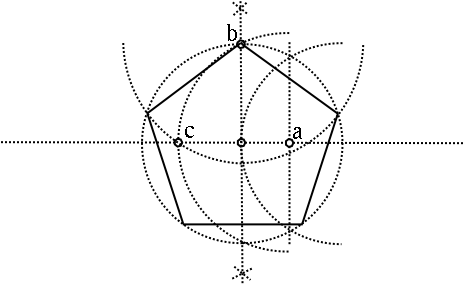Pentagon
|
|
Regular_pentagon.png
A regular pentagon
In geometry, a pentagon is any five-sided polygon. However, the term is commonly used to mean a regular pentagon, where all sides are equal and all angles are equal (to 108°). Its Schläfli symbol is {5}.
The area of a regular pentagon with side length a is given by
<math>A = \frac{5a^2}{4}\cot \frac{\pi}{5} = \frac {a^2}{4} \sqrt{25+10\sqrt{5}} \simeq 1.72048 a^2<math>
Regular_pentagram.png
A pentagram enclosed in a pentagon
A pentagram can be formed from a regular pentagon either by extending its sides or by drawing its diagonals, and the resulting figure contains various lengths related by the golden ratio, φ = (1+√5)/2.
Constructing a pentagon
A regular pentagon is constructible using a straightedge and compass. This process was described by Euclid in his Elements circa 300 B.C. Karl Friedrich Gauss made some theoretical proofs about the theory of polygons.
- Draw a horizontal line with a circle the size of your desired pentagon that has its center on this line.
- Put your compasses' needle where the circle's circumference crosses the horizontal line, and draw a half-circle through the center of your first circle, crossing the circumference of the first circle in two places. Draw a vertical line through the points where the half-circle crosses the first circle. This line will pass through a point we call (a).
- Open your compasses so that you can, when placing the needle in the two intersections between the horizontal line and the first circle, draw a small cross above and below the horizontal line, outside the first circle, with one line of the cross from each point. If you join these crosses you will obtain a line perpendicular to the horizontal line, also passing through the center of the first circle. The point where this line crosses the circumference of the first circle on the top, we call (b). This is the first corner of the pentagon.
- Put the compasses' needle in (a) and drawing a circle segment passing through (b) and down through the horizontal line, obtaining a point on this line we call (c).
- Put the needle in (b) and pass a circle segment through (c) and the first circle. These points on the first circle are the second and third corners of the pentagon.
- Without extending the compasses, put its needle in the second and third corners, and draw circle segments passing through the first circle to find the two remaining corners.
- Join each corner to the adjacent ones and you have a pentagon.
- If you join the non-adjacent corners (drawing the diagonals of the pentagon), you obtain a pentagram, with a smaller regular pentagon in the center. Or if you extend the sides until the non-adjacent ones meet, you obtain a larger pentagram.
External links
- Pentagons & Pentagrams (http://agutie.homestead.com/files/pentagram_menelaus1.htm) new facts about pentagons and pentagrams by Antonio Gutierrez from Geometry Step by Step from the Land of the Incas. Key concept: Menelaus Theorem.Template:Polygons
da:Femkant de:Fünfeck fr:Pentagone he:מחומש is:Fimmhyrningur it:Pentagono (geometria) ja:五角形 nl:Vijfhoek no:Pentagon pl:Pięciokąt pt:Pentágono sv:Pentagon zh:正五边形

